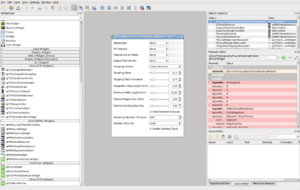Difference between revisions of "Documentation/4.0/Developers/Tutorials/QtDesigner"
| Line 32: | Line 32: | ||
$ ./Slicer4 --designer | $ ./Slicer4 --designer | ||
| | | | ||
| − | + | > cd Slicer-build | |
| − | + | > .\Slicer4.exe --designer | |
|} | |} | ||
{| | {| | ||
|[[Image:Screenshot-Qt Designer.png|thumb|300px|Qt Desginer loaded with CTKWidgets and qMRMLWidgets]] | |[[Image:Screenshot-Qt Designer.png|thumb|300px|Qt Desginer loaded with CTKWidgets and qMRMLWidgets]] | ||
|} | |} | ||
| + | |||
==Build Slicer== | ==Build Slicer== | ||
* Once you are satisfied with UI, save the file, quit Designer and build Slicer to take the changes into account. | * Once you are satisfied with UI, save the file, quit Designer and build Slicer to take the changes into account. | ||
Revision as of 03:41, 2 March 2012
Home < Documentation < 4.0 < Developers < Tutorials < QtDesignerBack to Developers Information←
Contents
Using custom widgets in Qt Designer
Straight to the point
- Windows
- Compile Slicer in Release mode OR build Qt in Debug
- All
cd Slicer-build; Slicer4 --designer
Qt Designer requirements
In order to have the CTK and MRML widgets in Qt Designer, Qt Designer offers 2 options:
- the first (not detailed here) is to copy (or symlink) the CTK and MRML plugin libraries into %QT_DIR%/plugins/designer,
- the second is to set the environment variable
QT_PLUGIN_PATHto the directory Slicer-build/bin containing the subdirectory designer with the plugin libraries.
Note: Qt requires that the directory containing the designer plugins is named "designer".
= Windows notes
On Windows, Qt Designer can only load plugins that have been compiled in the same build mode than Qt Designer. For example, if Qt is built in Debug mode, the plugins must also be built in Debug mode to be loaded by Qt Designer.
If Qt is configured to build in both debug and release modes, Qt Designer is built in release mode only. If that case, it is necessary to ensure that plugins are also built in release mode. Otherwise, you can open the solution file for Qt, and recompile Designer in debug mode.
Running Qt Designer with the correct environment variables
- On Windows, compile Slicer in the same build mode than Qt. If Qt is in Debug mode, compile Slicer in Debug mode, if it's in Release or Debug&Release mode, compile Slicer in Release mode.
- run Qt Designer via Slicer launcher located in Slicer-build.
| Mac Os X | Linux | Windows |
|---|---|---|
$ cd Slicer-build $ ./Slicer4 --designer |
> cd Slicer-build > .\Slicer4.exe --designer | |
Build Slicer
- Once you are satisfied with UI, save the file, quit Designer and build Slicer to take the changes into account.
| Mac Os X | Linux | Windows |
|---|---|---|
$ make -j4 |
Open the inner solution file ...Slicer-Superbuild\Slicer-build\Slicer.sln and build the solution (F7) or build project qSlicerMY_MODULE_NAMEModuleWidgets
| |
It generates a ui_qSlicerMY_MODULE_NAMEModule.h file in ...Slicer-Superbuild/Slicer-buildModules/Loadable/MY_MODULE_NAME/.
That file is used by ...Slicer4/Modules/Loadable/MY_MODULE_NAME/qSlicerMY_MODULE_NAMEModuleWidget.cxx.
Note: The objectNames of each widget in the UI correspond (see the Property editor) to the variable names in C++. From your code, you can access the widgets by their objectName.
- And launch Slicer to see the result
| Mac Os X | Linux | Windows |
|---|---|---|
$ ./Slicer |
.\Slicer.exe | |
